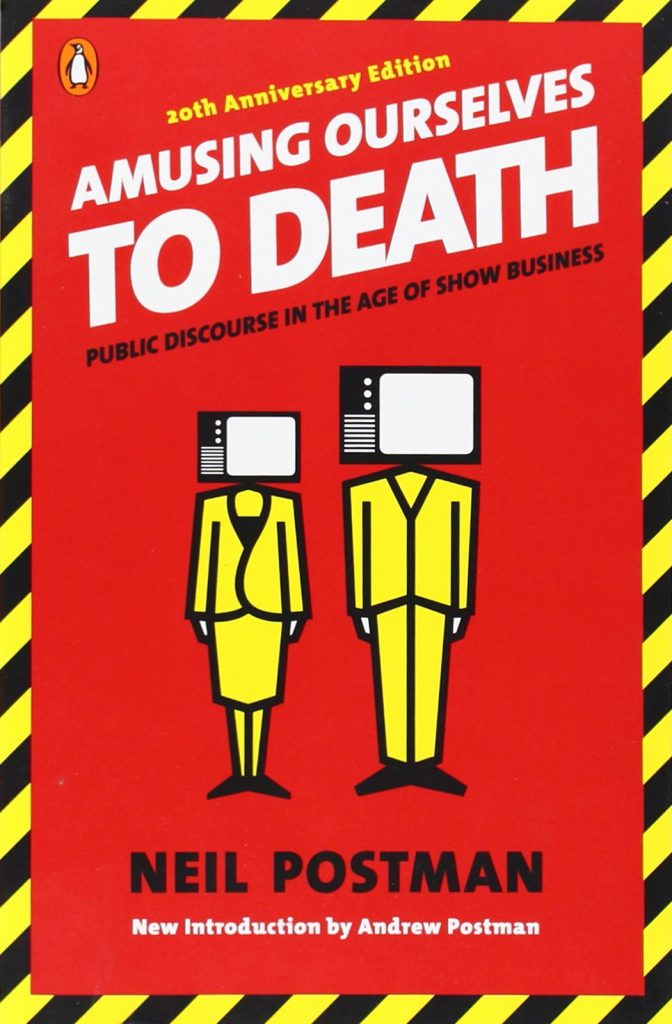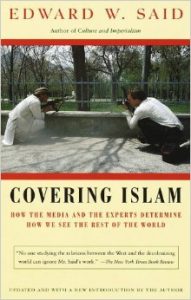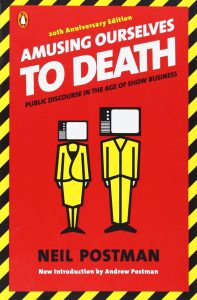In Amusing Ourselves to Death: Public Discourse in the Age of Show Business, Neil Postman explained that television “changed all aspects of public life (education, religion, politics and journalism) into entertainment” (vii). Television images “undermined other forms of communication, particularly the written word” (vii). Technology, such as customized TV programming, flat-screens and HDTV, made “content so abundantly available” (vii). Television overwhelmed people with information until “what was truly meaningful was lost (Aldous Huxley belief) and people no longer cared about what they lost as long as they were being amused” (vii).
Television served as a metaphor for entertainment. Television used “visual imagery” to express “discourse” and spark conversations between people (7). As television grew as a “medium” in the second half of the twentieth century, it led to the “decline of the Age of Typography” (8). The rise of the “Age of Television” shifted content and meaning of public discourse (8). Thus, according to Postman, languages served as our media. “Our media are our metaphors. Our metaphors created the content of our culture” (15).
The “media-metaphor shift” led public discourse to become “dangerous nonsense” (16). Television became a “carrier of important cultural conversations” (16). As a culture moved from “orality to writing to printing to television, its ideas of truth changed with it” (24). Truth served as a “product of conversation man has with himself about and through the techniques of communication he invented” (24). Intelligence “allowed one the ability to grasp the truth of things” (25). What a “culture meant by intelligence derived from the character of its forms of communication” (25). Changes to the “symbolic environment resembled changes in the natural environment, until a critical mass was achieved” (27). According to Postman, electronic media “changed the character of our symbolic environment” (28). As typography “moved to the periphery of American culture and television took its place at the center, the value of public discourse declined” (29).
From the seventeenth to the late nineteenth century, the “printed word and an oratory of the printed word dominated American society” (41). “There were no movies to see, radios to hear, photographic displays to look at or records to play” (41). Instead, people enjoyed the oratory of debates, such as the Lincoln-Douglas debates. These debates “served as preeminent examples of political discourse and illustrated the power of typography” (48). Unlike a television-based culture, the “Age of Exposition” put forward a “definition of intelligence that gave priority to the objective, rational use of the mind and encouraged forms of public discourse with logically ordered content” (51). The Age of Show Business, however, replaced the Age of Exposition. Communication and transportation created a “new metaphor of public discourse” (64). The invention of the telegraph eliminated the “problem of space, created the idea of context free information and made information in to a commodity” (65). The telegraph “moved information but did not collect, explain it or analyze it” (69). The rise of photography and television created a “peek-a-boo world, where now this event, now that, popped into view for a moment, then vanished again; but like a peek-a-book, it was endlessly entertaining” (77). Television, according to Postman, became “our culture” (79).
Television became the “principal mode of knowing” in society (92). Television staged the world and it became the model for how the world would be staged” (95). The 1984 US Presidential Debates supported the Age of Television. “The men were less concerned with giving arguments than with giving off impressions, which is what television does best” (97). Post-debate commentary avoided evaluation of the candidates’ ideals.
Music played a role in the rise of television. All television news programs “began, ended or punctuated with music somewhere in between” (102). As television and radio adopted the “now…this” phrase, the two mediums acknowledged the fact that the world was mapped by speeded-up electronic media that lacked order and meaning” (99). “We are “now thoroughly adjusted to the Now…this world of news—a world of fragments, where events stand alone, stripped of any connection to the past, or to the future or to other events” (110).
Television also played a role in understanding religion, politics and education in American society. Everything that made religion “historic, profound and sacred to human activity was stripped away; no sense of spiritual transcendence” (117). Politics became a direct form of show business thorough the use of television commercials. “On television, the politician did not “offer the audience an image of himself, as he offers himself as an image of the audience” (134). Education shows, such as Sesame Street, encouraged children to “love television instead of school and contributed to the idea that teaching and entertainment are inseparable” (144, 146).
“America gave the world a clear glimpse of the Huxleyan future through the Age of Television” (156). Postman said people must rely on schools to fix this issue. “It is a task of the schools to assist the young in learning how to interpret symbols of culture” (163). Postman also said it is important that people become aware of what television is. Thus, people will understand television and not let it control them in laughter.



